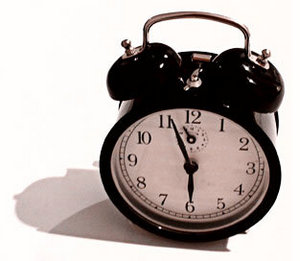Traditional bedside alarm clocks have been suffering physical abuse since the turn of the century. Flung across rooms; snooze buttons slapped with enough force to bludgeon a small child; power cords ripped savagely from unsuspecting wall sockets.
But what if there were an alarm clock that would wake you from your slumber with, say, the soothing sound of your choosing? Those already exist. I know.
But not like this. Not like the iHome alarm clocks and the cell phone alarms, which, as with most electronics that provide great convenience, cost a pretty penny. Most people still resort to the old school alarm clocks to avoid the high costs-but, what they don’t know is that Microsoft has inadvertently included a built-in, highly customizable alarm clock into Windows Vista and Windows 7.
Forking out wads of money just to have alarm clocks with customizable, mp3-playing alarms? Nay, an easy to setup and completely free alarm clock is lying dormant as we speak in your operating system. Not many people are familiar with it, mostly due to the fact that the program was originally intended for a completely different purpose. Alas, as stated, this is only possible with copies of either Windows Vista or 7. You XP users, stay classy.
How It Works
Windows Vista and 7 have hundreds of upgrades and new services, most notable Windows Aero and Aero Peek. Among these upgrades is an overhaul of the Administrative Tools, located in the Control Panel. These tools give any user with administrative privileges control to edit and customize Windows in hundreds of ways.
A program called Task Scheduler 2.0 has been included in the overhaul, and it does exactly as its name states: schedules tasks within Windows (tasks are commands sent out to programs, giving a user the ability to, say, start a program at a certain time or even have the computer turned on to perform a certain task hours or even days later).
Since Vista and 7 give a user all this power on a silver platter, the possibilities are endless; I won’t get into all of them-that could take a while. To take advantage of this feature in order to setup an alarm clock on your computer, here’s how to tell Vista or 7 to a play any sound or CD or mp3 file or video at any given time of the day, right down to the second.
In Windows Vista: Click on Start, then Control Panel, then Administrative Tools. Once the Administrative Tools window opens, click on the icon labeled Task Scheduler. Once that window opens you’ll be presented with three frames containing information and an abundance of icons. Do not fret. Things are about to get magical.
First, click on Create Basic Task. You’ll be asked to name the task. ‘Alarm Clock’ is a suitable name, but it’s completely up to your discretion. Next, Windows will ask you whether you want the task to run daily, weekly, monthly, one time, when the computer starts, when you log on, or when a specific event is logged. If this is a daily alarm clock, then, obviously, choose ‘daily’. If you only need to wake up once at oh-dark-thirty to catch a pre-dawn flight to the Galapagos Islands for a four-day tequila fiesta, then choose ‘one time’. Click ‘Next’.
You’ll be presented with four boxes: one for the date in which you want the alarm to start, one for the time in which you want it to start (in hours, minutes, and seconds), another box in which you can check if you want to synchronize the alarm over all time zones, and the last box allows you to choose how many days you wish for the alarm to recur. Fill out all the boxes according to your needs, then click ‘Next’.
Now here’s the important part: This next screen allows you to choose whether you want a program started, an e-mail sent, or a message displayed on the screen (high potential for pranksters). Click the START A PROGRAM option, then click ‘Next’. Technically, you’re not ‘starting’ a program on your computer once the time comes for your alarm to sound. What we’re going to do is tell your computer to open a music file, and since your computer can only open these kinds of files with Windows Media Player or Winamp or iTunes or whichever media player you’ve installed to play music, it has to play it upon opening the file. To put it simply: Task Scheduler tells your computer to open a file. Your computer finds the file and recognizes it is indeed music (i.e., mp3, wma, flac, etc.). Your computer opens the file with whichever program, by default, that your computers plays music with.
Now that we’ve got that covered, the current shows a text field with a ‘Browse’ button beside it. Click this button. A box will pop up allowing you to search within your computer for whichever music or video file you please. Once you’ve found the file, click it ONCE to select it, then click the ‘Open’ button. The box will go away the text field will be filled with the location to the file in your computer. Click ‘Next’.
You’ll be presented with an overview of the information of your alarm: Name, Description, Trigger (start time and date), and Action (the location of the file in your computer). Click ‘Finish’.
After this the original Task Scheduler window appears, but your alarm is nowhere to be seen. Again, do not fret. Simply click on the Task Scheduler Library button on the left of the window. You’ll be presented with a list of tasks Windows has stored and is awaiting to execute, along with their ‘Status’ and ‘Triggers’. Find your alarm, right click on it, then click ‘Enable’.
If you would like to edit the alarm some more (i.e., whether or not to run the alarm when your logged on or not, to turn your computer on when it’s time to start the alarm if it is somehow off for some reason, etc.), simply right click on the task in the list and click ‘Properties’. Follow these steps if you would like to edit the alarm’s time or date, then click on the ‘Triggers’ tab, then the ‘Edit’ button.
And there you have it. Your own alarm clock, right there on your computer. Keep in mind that if you’re a heavy sleeper, turn the volume up a considerable amount before you dose off, that way you’ll be rocked out of unconsciousness when the time comes (possibly to the sweet sounds of Metallica).
In Windows 7: Follow the same process as described above, only you can reach the Administrative Tools window more easily by clicking Start then hovering your mouse over the Administrative Tools section on the right of the menu, then clicking Task Scheduler.
Enjoy your new free, awesome alarm clock. If you’re wondering what song I have set as mine, then wonder no more: St. Anger by Metallica. That’s right. Jolted from my slumber by the savage beating of wood on drums and angry riffs on guitars, all while someone grunts intermittently into a mic.






